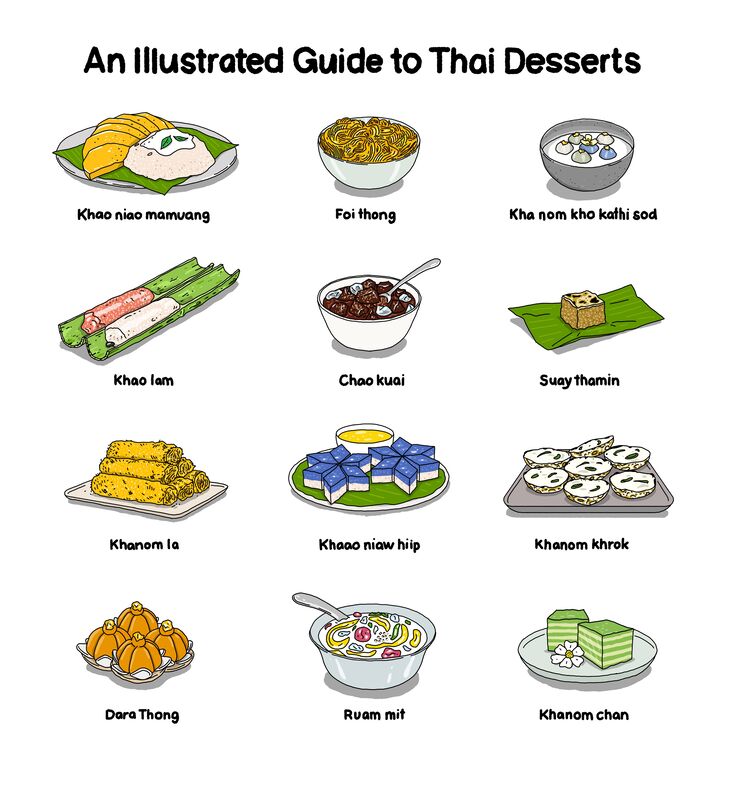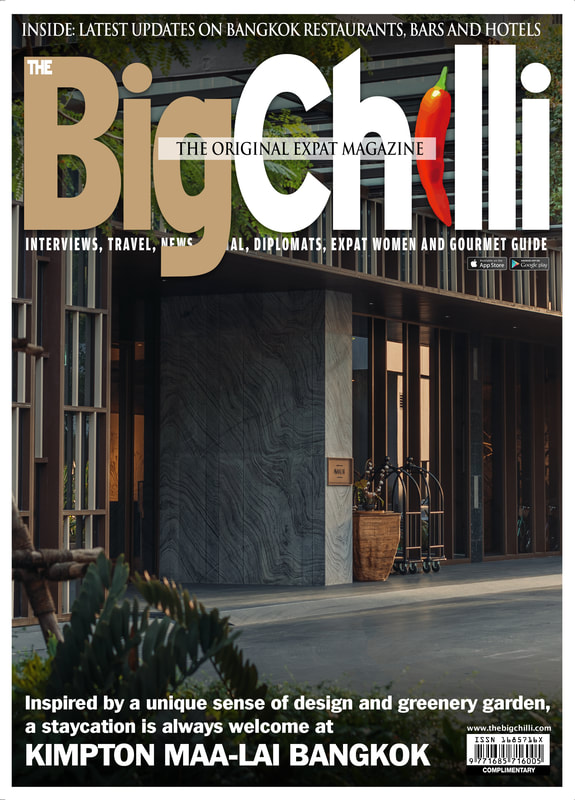Thai desserts exist in breathtaking variety. There are golden sweets made from egg yolk and sugar (a confection derived from the Portuguese) formed into delicate threads or molded to resemble the seeds of jackfruit. There is khanom kho kathi sod, a Southern Thai dessert of glutinous rice balls stuffed with grated coconut in warm coconut milk that’s traditionally served at auspicious ceremonies. There’s suay thamin, a dessert from Mae Hong Son in Thailand’s north made of steamed sticky rice and raw sugarcane sugar topped with a generous serve of salty coconut custard for good measure. In this illustrated guide, we take a deep dive into the delicious and colourful world of Thai desserts.
1. Khao niao mamuang – ข้าวเหนียวมะม่วงThere’s no dessert from Thailand better known than sweet sticky rice with mango. Glutinous rice is steamed, doused in sweetened coconut milk and served warm alongside fresh, cool sliced mango. A ripe mango is essential, so the best time to eat khao niao in Thailand is April and May during the peak mango season. Of course, this classic and simple dish has travelled the world and while it originated in Thailand, you can commonly find it throughout Southeast Asia including Laos, Cambodia and Vietnam.
2. Foi thong – ฝอยทองWhat do Portuguese and Thai sweets have in common? A lot, actually. Thai desserts are heavily influenced by Portuguese traditions thanks to one lady: Maria Guyomar de Pinha. Born in 1664 to a Portuguese father and Japanese mother, Maria ended up in charge of the royal household kitchen where she introduced – or at least publicised – the use of egg yolks and refined sugar in Thai sweets. Many desserts she crafted then have become Thai classics including tong yip, tong yod and foi thong. Called fios de ovos in Portuguese, in Thailand this confection is made by drizzling egg yolks (usually duck eggs) through a narrow funnel into sugar syrup, making long, thin, delicate golden threads.
3. Kha nom kho kathi sod – ขนมโคกะทิThis traditional Southern Thai dessert appears at ceremonies designed to bring prosperity. The sweet coloured balls are made of glutinous rice flour coloured with natural ingredients like butterfly pea flowers for blue and pandan for green. Each ball is stuffed with grated coconut and served in a bath of warm coconut milk. One of the best places to try this dish is at the House of Smooth Curry in Bangkok.
4. Khao lam - ข้าวหลามEnjoy sweets with a side of theatrics? Seek out khao lam at street food stalls in Conburi province. Sweet sticky rice – white or black – is mixed with red beans and coconut, stuffed into long bamboo tubes and topped with coconut milk. The bamboo is sealed and placed over hot coals where it slow cooks creating a sweet, rich and custardy texture. When you order the bamboo baton the vendor will whack the tube open with a hammer or knife, making it easy to access the prized rice cake inside.
5. Chao kuai – เฉาก๊วยOriginally a Chinese dish, you’ll find chao kuai all over Thailand usually served with crushed ice and a sprinkling of brown sugar. The dark-coloured grass jelly is made using the slightly oxidised leaves and stalks of Mesona chinesis, a type of mint, which is boiled for several hours before being left to cool and turn from liquid to solid. In some areas you’ll find it served with condensed or evaporated milk or mixed with fruits like mango, watermelon, jackfruit, sago or canned fruits.
6. Suay thamin – ส่วยทะมินFor something a little different, this dessert from the Tai Yai people can be hard to find and may require trekking up to Mae Hong Son in Thailand’s deep north to taste it. The region borders Myanmar, and so you’ll find other dishes and desserts influenced by the Burmese population. Suay thamin is a steamed cake made of steamed sticky rice and raw sugarcane sugar, topped with a generous slathering of salty coconut custard for good measure.
7. Khanom la - ขนมลาThe tenth lunar month is a big celebration in southern Thailand, and big celebrations call for special sweets. Khanom la is one of five snacks and desserts used as offerings during the traditional Ngan Boon Duen Sib festival in September or October. The golden net is made by frying fine strands of rice flour, egg-yolk and sugar in a pan. Traditionally the batter was poured into the pan via a coconut shell with holes in the bottom, but now people use metal tins with holes punched out. The resulting sweet web is quickly shaped into a few different designs. The delicate final product is meant to represent the offering of clothes to the spirits of the dead and it’s best to visit Nakhon Si Thammarat province to try it.
8. Khao niew hieb– ข้าวเหนียวหีบYou’ll spot these little blue-and-white sticky rice diamonds at wedding ceremonies in Phuket. This traditional dessert is one of 10 sweets that represent goodwill and khao niew hieb symbolises the love and connection between two families. The two sticky rice components – the blue is made using butterfly pea flowers – are compressed as one, then sliced and served with a sweet egg and coconut custard on the side.
9. Khanom khrok – ขนมครกSometimes called a pancake, pudding or cake, this popular street food sweet is made of rice flour and coconut milk and baked in large iron pans with small, round indentations. Each khanom khrok is made in two parts so each has a crunchy outer layer and soft, custardy centre. The batter hits the hot pan forming a crispy bottom shell before lightly sweetened coconut milk fills the cup. Both salty and sweet, the little ancient pancakes are often filled with sliced spring onion, taro, corn or pumpkin.
10. Dara thong – ดาราทองThese little golden crowns are a traditional Thai egg-based dessert served on special occasions. Dara thong means golden star and this sweet can also be called thong ek. The dough is made from wheat flour, egg yolks, coconut milk, sugar and sometimes jasmine-flavoured water. The mixture is shaped into little crowns, decorated with sugar-coated watermelon seeds and topped with a tiny piece of gold leaf. It’s believed dara thong was created in the 1930s in a dessert competition.
11. Ruam mit รวมมิตรIt’s said that ruam mit is a recipe without an ingredients list as every vendor in Thailand has a different take on this popular street food sweet. Expect a bright bowl of sweet, starchy noodles flavoured and coloured with different ingredients like sweet potato, beans, tapioca pearls, jackfruit and corn. The coloured noodles might be sliced into thin strips or more elaborate shapes. This cheap dessert is served cold, often topped with ice, and is extremely refreshing on hot days.
12. Khanom chan (ขนมชั้น)In Thai the word “nine” is a homophone of “to step forward” and so this nine-layered sweet is a favourite for big celebrations and ceremonies. Originating from the ancient Sukhothai period, the steamed coconut and pandan cake always has at least nine layers and represents prosperity in life and job promotions. Starches like rice, tapioca and arrowroot flour are made into a batter with coconut milk. The batter is divided in two: one half flavoured with jasmine, the other with jasmine and pandan, which gives a bright green colour and sweet herby fragrance. Making this dish is a labour of love as each layer needs to be steamed before adding the next. The result? A fragrant, subtly sweet and slightly oily sticky cake. While traditionally the cake alternates layers of green and white, these days people make khanom chan with different colours and flavours.
2. Foi thong – ฝอยทองWhat do Portuguese and Thai sweets have in common? A lot, actually. Thai desserts are heavily influenced by Portuguese traditions thanks to one lady: Maria Guyomar de Pinha. Born in 1664 to a Portuguese father and Japanese mother, Maria ended up in charge of the royal household kitchen where she introduced – or at least publicised – the use of egg yolks and refined sugar in Thai sweets. Many desserts she crafted then have become Thai classics including tong yip, tong yod and foi thong. Called fios de ovos in Portuguese, in Thailand this confection is made by drizzling egg yolks (usually duck eggs) through a narrow funnel into sugar syrup, making long, thin, delicate golden threads.
3. Kha nom kho kathi sod – ขนมโคกะทิThis traditional Southern Thai dessert appears at ceremonies designed to bring prosperity. The sweet coloured balls are made of glutinous rice flour coloured with natural ingredients like butterfly pea flowers for blue and pandan for green. Each ball is stuffed with grated coconut and served in a bath of warm coconut milk. One of the best places to try this dish is at the House of Smooth Curry in Bangkok.
4. Khao lam - ข้าวหลามEnjoy sweets with a side of theatrics? Seek out khao lam at street food stalls in Conburi province. Sweet sticky rice – white or black – is mixed with red beans and coconut, stuffed into long bamboo tubes and topped with coconut milk. The bamboo is sealed and placed over hot coals where it slow cooks creating a sweet, rich and custardy texture. When you order the bamboo baton the vendor will whack the tube open with a hammer or knife, making it easy to access the prized rice cake inside.
5. Chao kuai – เฉาก๊วยOriginally a Chinese dish, you’ll find chao kuai all over Thailand usually served with crushed ice and a sprinkling of brown sugar. The dark-coloured grass jelly is made using the slightly oxidised leaves and stalks of Mesona chinesis, a type of mint, which is boiled for several hours before being left to cool and turn from liquid to solid. In some areas you’ll find it served with condensed or evaporated milk or mixed with fruits like mango, watermelon, jackfruit, sago or canned fruits.
6. Suay thamin – ส่วยทะมินFor something a little different, this dessert from the Tai Yai people can be hard to find and may require trekking up to Mae Hong Son in Thailand’s deep north to taste it. The region borders Myanmar, and so you’ll find other dishes and desserts influenced by the Burmese population. Suay thamin is a steamed cake made of steamed sticky rice and raw sugarcane sugar, topped with a generous slathering of salty coconut custard for good measure.
7. Khanom la - ขนมลาThe tenth lunar month is a big celebration in southern Thailand, and big celebrations call for special sweets. Khanom la is one of five snacks and desserts used as offerings during the traditional Ngan Boon Duen Sib festival in September or October. The golden net is made by frying fine strands of rice flour, egg-yolk and sugar in a pan. Traditionally the batter was poured into the pan via a coconut shell with holes in the bottom, but now people use metal tins with holes punched out. The resulting sweet web is quickly shaped into a few different designs. The delicate final product is meant to represent the offering of clothes to the spirits of the dead and it’s best to visit Nakhon Si Thammarat province to try it.
8. Khao niew hieb– ข้าวเหนียวหีบYou’ll spot these little blue-and-white sticky rice diamonds at wedding ceremonies in Phuket. This traditional dessert is one of 10 sweets that represent goodwill and khao niew hieb symbolises the love and connection between two families. The two sticky rice components – the blue is made using butterfly pea flowers – are compressed as one, then sliced and served with a sweet egg and coconut custard on the side.
9. Khanom khrok – ขนมครกSometimes called a pancake, pudding or cake, this popular street food sweet is made of rice flour and coconut milk and baked in large iron pans with small, round indentations. Each khanom khrok is made in two parts so each has a crunchy outer layer and soft, custardy centre. The batter hits the hot pan forming a crispy bottom shell before lightly sweetened coconut milk fills the cup. Both salty and sweet, the little ancient pancakes are often filled with sliced spring onion, taro, corn or pumpkin.
10. Dara thong – ดาราทองThese little golden crowns are a traditional Thai egg-based dessert served on special occasions. Dara thong means golden star and this sweet can also be called thong ek. The dough is made from wheat flour, egg yolks, coconut milk, sugar and sometimes jasmine-flavoured water. The mixture is shaped into little crowns, decorated with sugar-coated watermelon seeds and topped with a tiny piece of gold leaf. It’s believed dara thong was created in the 1930s in a dessert competition.
11. Ruam mit รวมมิตรIt’s said that ruam mit is a recipe without an ingredients list as every vendor in Thailand has a different take on this popular street food sweet. Expect a bright bowl of sweet, starchy noodles flavoured and coloured with different ingredients like sweet potato, beans, tapioca pearls, jackfruit and corn. The coloured noodles might be sliced into thin strips or more elaborate shapes. This cheap dessert is served cold, often topped with ice, and is extremely refreshing on hot days.
12. Khanom chan (ขนมชั้น)In Thai the word “nine” is a homophone of “to step forward” and so this nine-layered sweet is a favourite for big celebrations and ceremonies. Originating from the ancient Sukhothai period, the steamed coconut and pandan cake always has at least nine layers and represents prosperity in life and job promotions. Starches like rice, tapioca and arrowroot flour are made into a batter with coconut milk. The batter is divided in two: one half flavoured with jasmine, the other with jasmine and pandan, which gives a bright green colour and sweet herby fragrance. Making this dish is a labour of love as each layer needs to be steamed before adding the next. The result? A fragrant, subtly sweet and slightly oily sticky cake. While traditionally the cake alternates layers of green and white, these days people make khanom chan with different colours and flavours.




















